South African Military History Society - Journal (original) (raw)
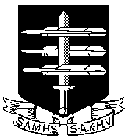 The South African
The South African
Military History Society
Die Suid-Afrikaanse Krygshistoriese Vereniging
Military History Journal
Vol 14 No 2 - December 2007
LUDWIG KREBS
A naturalist's observations of the Sixth Fronteir War (1834-5)
By Marian Baker
Introduction
If one takes the road to the village of Bedford in the Eastern Cape and then turns off on to the narrow dirt road to Tarkastad, one will travel along a remote but spectacular valley known today as the 'Baviaan's River Conservancy'. This area was once home to the Prinsloos who participated in the Slagtersnek Rebellion and, later, to the Scottish 1820 settler party led by Thomas Pringle. The topography today is as dramatic as when it was described by Thomas Pringle in his Narrative, published in 1834:
' ... we beheld a beautiful vale, about six or seven miles in length, and varying from one or two in breadth. It appeared like a verdant basin, or cul de sac, surrounded on all sides by an amphitheatre of steep and sterile mountains, rising in the background into sharp cuneiform ridges of very considerable elevation.' (Pringle in Wahl, 1970, p65).
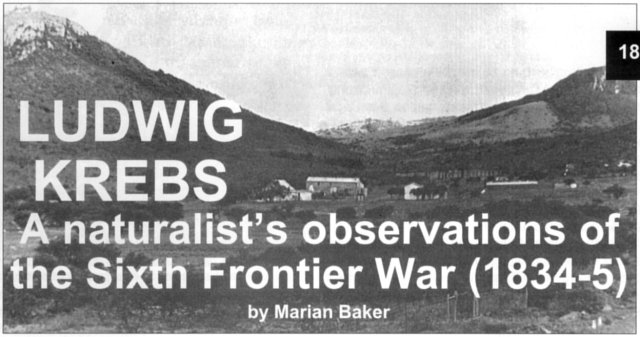
Lichtenstein Farm, Eastern Cape
(Photo: ffolliatt & Liversage, 1971).
The Baviaan's River Valley provided writers such as Pringle with a romantic setting which was congruent with many of the ideas and sentiments of the early 19th century, which valorised the sublimity of nature. The 1820s and early 1830s saw the perpetuation of many of the ideas informing the Romantic Movement (early 19th Century) which based much of its aesthetics on intuitive responses to nature. Contemporaneously, scientific discourses drawing on earlier Enlightenment principles were becoming more formalised and coherent. A major impetus of the scientific endeavour sought to subject nature to empirical study, to classify specimens and to find ways to utilise plant and animal species for commercial purposes.
Notwithstanding his aesthetic appreciation of nature, Ludwig Krebs's interests were primarily scientific: he was intensely curious about the natural world and was an indefatigable and, at times, expedient collector of 'animal and vegetable' species. Later in life, he was caught up in the Eastern Frontier conflicts and it is his account of his experiences of the 6th Frontier War of 1834 which will be the major focus of this article.
Early life
Ludwig Krebs was born in Wittengen in Hanover (now Germany) in 1792. He apprenticed as an apothecary, probably in Hamburg, and, by the time he came out to the Cape in 1817, he was a qualified apothecary. He worked for the pharmacy of Pallas and Polemann in Cape Town until 1821. In addition to his pharmaceutical work, Krebs started collecting natural specimens around Cape Town. It was while in Cape Town that he initiated a business arrangement with Dr Lichtenstein, who had also been a collector of specimens and a commentator on early 19th century Cape life. The subsequent account of Lichtenstein's travels was published as Travels in Southern Africa, 1803-1803. When he returned to Europe, Lichtenstein was appointed Director of the Berlin Zoological Museum in Prussia. Krebs offered his services as a professional collector of South African biological specimens and also proposed to Lichtenstein that he organise the shipping of these items to Prussia. His proposal was accepted and he was appointed 'Cape Naturalist to the King of Prussia' in 1821 (ffolliott and Liversage, 1971).
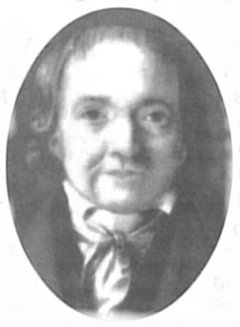
Naturalist L Krebs
(Photo: ffolliat & Liversage, 1971).
In the 1820s, Krebs moved to the Eastern Cape and initially spent some time in the Uitenhage district. He finally settled in the Baviaan's River Valley where he purchased the farm, Doornkroon. Krebs took official possession of the farm in 1832 and renamed it 'Lichtenstein' in honour of his patron. Some years prior to this, the farm had been loaned to Hendrik Prinsloo, one of the major protagonists in the Slagtersnek Rebellion who was subsequently hanged for his role in the Rebellion. The farm was then granted to Lieut Devenish who had served with the 85th Regiment until 1815, when he had been transferred to the Cape Corps. Devenish established a successful and well-stocked farm, but dissipated his prospects ' ... on account of a misalliance [with his wife] and drink ... ' (ffolliatt and Liversage, 1971, p80).
Krebs had visited the Baviaan's River area in 1825 while hunting for botanical and zoological specimens and had been struck by its beauty and by its varied and interesting collecting opportunities. Thus he intended to use his farm as a base for his natural history expeditions while continuing stock farming and horticulture. Krebs provided a very favourable description of his farm in a letter to Lichtenstein:
'The Farm, for one in the African country, is quite romantic, consisting of a valley of little more than one German mile in length (about 6 English miles [9,6km]) ... surrounded by high mountains ... My farm, however, has the best grazing lands and with its mountain, has usable veld of about 6 000 morgen, which offers good grazing for horses, cattle, sheep and goats ... The previous owners of this farm planted many fruit trees, amongst which are apples, pears (delicious), plums, apricots, quinces and pomegranate, some of which give more fruit than can be eaten here. The trellis put down by my predecessor has 5 000 vines' (ffolliatt and Liversage, 1971, p89).
Krebs's pastoral orderliness and security was to be shattered when, two years after he had bought the farm, it was to become a defence post during the Sixth Frontier War. This war began in December 1834 and lasted nine months. It was initiated by the amaXhosa, who began their attack in the Albany area of the Eastern Cape. Farms were besieged and torched, cattle were carried off and a number of settlers were killed. Subsequently, villages and towns such as Bathurst, Salem and Fort Beaufort were attacked. Besides the onslaughts on these larger settlements, most of the conflict took the form of skirmishes and, as Peires (1981) points out, 'guerilla' tactics were most commonly used:
'The Xhosa told missionary Young that "they shall not all come in a body as before but they will divide themselves into separate parties, and each party must have their own route appointed them, and in this way they can avoid our troops, and come upon the settlers and the Boers before they have time to collect themselves together" ... The Colony found itself faced not with a single enemy to be shattered by overwhelming fire power, but with innumerable small detachments which it was unable to pin down' (Peires, 1984, p165).
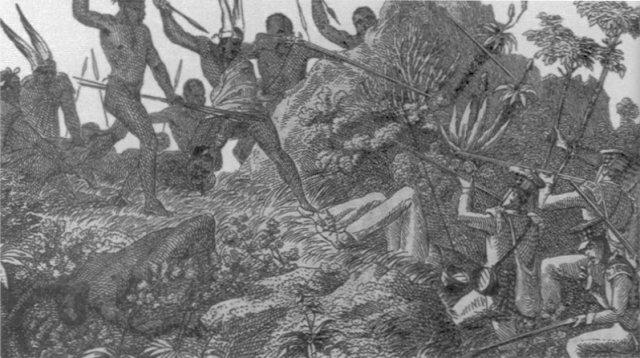
A battle scene (detail from a sketch in B A le Cordeur [ed],
The Journal of Charles Lennox Stretch, Maskew Miller Longman, 1988).
There was often fierce skirmishing in the bush, as Captain Alexander of the 42nd (the Royal Highland) Regiment was to relate: 'It is certainly no child's play tracking through the dense bush by a narrow path in Indian file, having a volley of musquetry suddenly poured on the party from above, and stalwart and naked warriors rushing with yells and stabbing assegais from the elephant grass around' (quoted in Mostert, 1992, p691).
Initially, the incursions caused widespread panic and confusion amongst the settlers. Forces under Col Henry Somerset (the military commander of the Frontier) did little to forestall the amaXhosa attacks on farms and villages. Lt-Col Harry Smith (at that time, second-in-command of the British military forces at the Cape) was ordered by Sir Benjamin D'Urban, the Cape Governor and Commander-in-Chief in South Africa, to proceed to the Frontier and to take charge of the forces there. Immediately after Smith's dramatic six day ride from Cape Town and his arrival in Grahamstown, he declared martial law on the Frontier. He also set about organising the defence of Grahamstown and ordered a number of punitive attacks on the amaXhosa. By the time Sir Benjamin D'Urban arrived in Grahamstown in January 1835, the amaXhosa had lost their momentum and had retreated to more defensive positions around the Amatole Mountains and in the Fish River bush. In the first few months of 1835, D'Urban's forces (a combination of local settlers, levies and regular British forces such as the 75th Regiment and the 72nd Highland Regiment), with Col Harry Smith as Chief of Staff, had managed to clear the amaXhosa from the Fish and Cowie River areas. This was followed by a war of attrition against the amaXhosa in the Amatole region, which finally led to a peace agreement between D'Urban and certain Xhosa chiefs at Fort Willshire in September 1835 (Mostert, 1992).
Krebs's account of the Sixth Frontier War is interesting not only because it is a personal account, but also because it provides a detailed exposition ofthe defence and combat strategies of some of the frontier farmers at that time. Even though Krebs did not join the local commandos, he experienced many of the exigencies of the conflict and had a number of guards attached to his property. The reorganisation of his farmstead demonstrated the typical and effective defence strategy of the period - that of the laager. His letters also provide evidence that settlers often had to fend for themselves in the conflict, as well as lay out money to provide for the protection of their property and its occupants. They also point to the immense importance of protecting one's livestock, which was, at that time, the lifeblood of the both the frontier farmers and the pastoralist amaXhosa (Beinart, 2005).
This summary of Krebs's account of the War is taken from a letter written to Lichtenstein in 1835:
'Following the official news of the attack by the natives, I sent a messenger on horseback to Somerset and asked Mr Ziervogel (the magistrate in Somerset East) ... to send me a guard of colonists, as I would not like to leave my farm. However, Mr Ziervogel had already rushed into the field to try to cope with assistance to the hastily gathered colonists, to prevent the Kaffirs [_sic_] from further progress in this part of the Colony .. .'
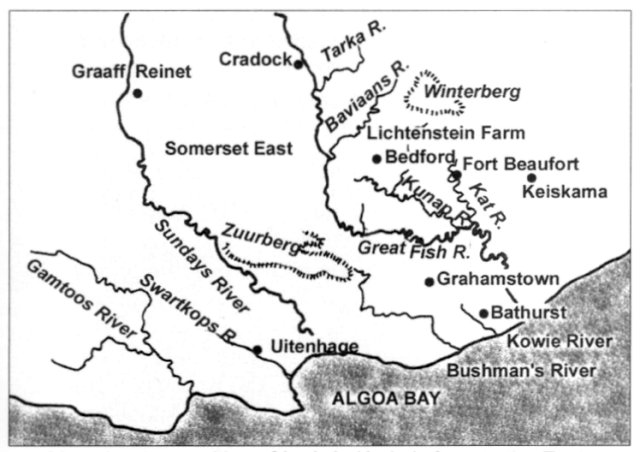
Map showing position of Ludwig Krebs's farm in the Eastern Cape
(adapted from map in ffolliatt & Liversage, 1971).
'In the meantime I had small barricades set up near the entrance to my house, and stone walls built with loopholes and also loopholes made in the out buildings ... I had the barricades completed and sent servants on horseback to the various outposts of my farm to find out whether spoors and tracks of Kaffirs [sic] could be found. When, towards evening, I saw smoke arise from burning houses in the east, my farm appeared to be next in the line of attack from the barbarians. The danger became even greater every minute, as most probably the Kaffirs [_sic_] already seen in the nearby Cowie Wood would attempt attack during the night. .. I again examined all my guns and positioned them handily. I then went into my room and being tired, I lay down on the settee, thinking about my distressing position' (ffolliat and Liversage, 1971, p93).
As it turned out, Krebs and his servants did not have to defend his farm alone. That night a commando of men with 'shining guns' rode onto the farm and positioned more guards around the kraals. The next day there were 60 men stationed at Krebs's farm, followed by thirteen families seeking protection and a 'great number of Tambookies and Mantatees who had fled here and who with their wives and children numbered over one hundred' (ffolliatt and Liversage, 1971, p94).
'The wagons of all families were placed in a semicircle near the house and within, the horses were tied up during the night. They [the horses] numbered about 300. The farm looked very warlike thus, and the collection of men and animals caused me, as head of these things so hastily gathered together, great worry about where provisions and grazing would come from if the war were to last for some time. With such a great number of armed men together, they undertook daily patrols into the nearby forests and Kaga Mountain. During their first patrol they found below the forest several fires with Kaffirs [_sic_] busy cooking one of my oxen. They were in such a hurry to get into the forest away from the colonists that only one of them could get hit. During the following night they were audacious enough to sneak around the Kraals, but did not do anything, from what we could see from their spoors' (ffolliatt and Liversage, 1971, p94).
Understandably, Krebs began to worry about the costs of provisioning the commandos and providing food and grazing for the refugees and animals which were gathered on his farm. The commandos, who turned out to be a mixed blessing, were not permanent and were constantly being deployed to other parts of the Frontier. This left Krebs vulnerable and, judging from his narrative, he either seems to have had insufficient men to assist him in the protection of the farm, or he had to take individual responsibility for its safety.
In a letter to Andries Stockenstrom, the Lieutenant-Governor of the Cape and also a close neighbour and friend, he wrote: 'I hear there are 60 men at the Post and 40 at Koza, if that is so, can you send me another 10. Meanwhile there are about 22 here, so we are short of men. Last night I checked the watch (Posten) every two hours and for the last four nights have had little sleep ... I am still providing the people with ammunition and provisions ... If this is to take a long time, I would find it very difficult. If the government expects her people to look after the safety of her land, shouldn't she provide provisions? Please could you help me with ammunition if you can' (ffolliatt & Liversage, 1971, p97).
Later, he wrote, 'As you can see from the following letter we are still in the labyrinth ... ' More stock had been raided from his farm and he wrote that 'I go around every night until about one o'clock to see if all the watchmen are at their posts, and am quite wild in my head' (ffolliatt & Liversage, 1971, p98).
Even though Krebs witnessed skirmishes on the mountainside close to his farm and had a number of his cattle and sheep rustled, he tenaciously held on at the farm. He resisted invitations from Stockenstrom to decamp to his farm, Maastrom, which Krebs described as a 'romantic farm' which was situated '2 hours by horse away from me'. However, there were times when Krebs became increasingly anxious about the crisis. He once wrote to Stockenstrom, 'If I am forced to leave my farm and take up your friendly offer, can I bring somewhat more than 2 000 sheep and goats with me? .. I think it would be better for me to stay here and any able bodied men to be sent here. This I think is necessary as the mountains from here to Katberg are open' (ffoliatt & Liversage, 1971, p99).
When Krebs's farm finally emerged 'from the labyrinth' at the end of the War, he considered his losses 'bearable' compared to other colonists. A number of his stock had been rustled but his farmhouse had not been affected, nor had he lost any of his numerous protegees. However, there were other regrettable 'losses' on his farm. Always the naturalist, he wrote to Lichtenstein that 'I also have to deplore the loss of the living Gypaetos barbatus [the Bearded Vulture] of which I have advised earlier. But the Buceros is still with me alright.' The Buceros was a pet Ground Hornbill called Carolus, which seemed to have been a much pampered addition to the Krebs household (ffolliatt and Liversage, 1971, p96).
Krebs died in 1844. His health, which had never been very good, had been further undermined by his exacting and strenuous collecting trips into the interior of South Africa. He was buried on Lichtenstein, and his simple, secular headstone can still be seen on the farm.
Krebs left an important legacy to the world of South African natural history. The numbers of the specimens he sent to Prussia were extraordinary: 244 animals, 3285 birds, approximately 20 000 insects and hundreds of plant species (ffolliatt & Liversage, 1971). His 'scientific' activities and personal attributes were acknowledged in the following obituary, published in the Graham's Town Journal on 16 May 1844:
'By a notice on our front page, our readers will learn of the demise of Lodwyk [_sic_] Krebs, Esq, whose scientific acquirements as a naturalist have rendered his name familiar to the frontier inhabitants generally. Deceased was, we believe a member of some of the learned societies of Europe and was employed for several years under the patronage of the King of Prussia, in collecting specimens, chiefly botanical, for the public museum of that city [_sic_]). He resided on this frontier for the last 22 years, for the greater part of which period his sufferings were intense, arising from a severe rheumatic complaint which baffled all the powers of medicine for its removal, and which, we are informed, was induced by exposure to the weather in the prosecution of his favourite professional researches. For some years past, Mr Krebs dwelt upon a farm of his own at the source of the Baviaans River, where he was much esteemed for his high intelligence and for his readiness to provide for, as far as in his power, the welfare of all within the sphere of his influence.
As a man of cultivated mind, of scientific attainments and of strict sobriety of life, his death must be viewed as a loss to the Colony at large' (ffolliatt and Liversage, 1971, p138).
The South Africa 1853 Medal
Ludwig Krebs died about ten years before the South Africa 1853 Medal became available. As a 'civilian', he probably would not have been deemed an eligible recipient. In fact, according to Everson (1978), only a small number of the 'colonials' received the medal. The South Africa 1853 Medal was awarded to those who survived and had been engaged in one or more of the Frontier Wars of 1834-5, 1846-7 or 1850-3. Recipients included Regular Army officers and men, the Cape Mounted Riflemen and a few colonials. Medals were also granted to certain naval units involved in the 1850-3 War (Everson, 1978).
Concerning the colonial levies who participated in the 1834-5 Frontier War, Mostert (1992) writes that 'Smith began drafting in Boers from all over the colony and impressed all available Khoikhoi ... several hundred of the British settlers were also drafted ... The Boers and British were issued with rations and ammunition but received no pay. The Khoikhoi were put on the same pay as the British regulars. Altogether some 1 300 of these auxiliaries were to be attached to his cavalry or infantry units during the war.' AmaXhosa figures opposing the British in the 1834-5 War were estimated at between 10 000 and 15 000 (Mostert, 1992, p686).
Bibliography
- Beinart, W, The Rise of Conservation in South Africa (Oxford, Oxford University Press, 2005).
- Everson, G R, The South Africa Medal (London, Samson Books, 1978).
- ffolliatt and Liversage, Ludwig Krebs (Cape Town, Balkema, 1971).
- Gordon, L L, British Battles and Medals (London, Spink, 1979).
- Mostert, N, Frontiers (London, Pimlico, 1992). Peires, G, House of Phalo (Jeppestown, Jonathan Ball,2003).
- Wahl, J (Ed), Thomas Pringle in South Africa 1820-1826 (Cape Town, Longman, 1970).
Return to Journal Index OR Society's Home page
South African Military History Society /scribe@samilitaryhistory.org